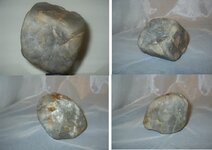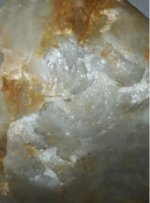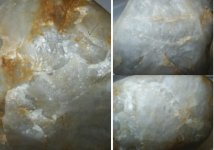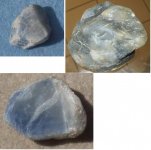The rock in the photography has a cloudy outer layer of approximately 3 - 5 mm of thickness; where that layer has been removed appears with an intense brightness metallic silver colour ( see closeup), its hardness is greater than the quartz. What rock could be?
Navigation
Install the app
How to install the app on iOS
Follow along with the video below to see how to install our site as a web app on your home screen.
Note: This feature may not be available in some browsers.
More options
You are using an out of date browser. It may not display this or other websites correctly.
You should upgrade or use an alternative browser.
You should upgrade or use an alternative browser.
More hardness than quartz -- help id
- Thread starter tavernier
- Start date
pegleglooker
Bronze Member
- Jun 9, 2006
- 1,857
- 238
- Detector(s) used
- ace 250
- Primary Interest:
- All Treasure Hunting
tag
Upvote
0
Eu_citzen
Gold Member
- Sep 19, 2006
- 6,484
- 2,111
- Detector(s) used
- White's V3, Minelab Explorer II & XP Deus.
- Primary Interest:
- Prospecting
I don't think you could fail so badly with a hardness test.... :Pallen_idaho said:gypsum
I think it's quartz. If you scratch quartz against quartz it should not happen anything as they are the same hardness.
Else I would also consider it really.
Upvote
0
Hemisteve
Sr. Member
- Feb 21, 2008
- 459
- 123
- Detector(s) used
- Goldmaster V/Sat and MXT
- Primary Interest:
- All Treasure Hunting
It could be Adventurine, a quartz with other minerals mixed in.
You mentioned a metallic luster but the photo does'nt show to well.
Do a Google search for quartz.
Steve
You mentioned a metallic luster but the photo does'nt show to well.
Do a Google search for quartz.
Steve
Upvote
0
Eu_citzen
Gold Member
- Sep 19, 2006
- 6,484
- 2,111
- Detector(s) used
- White's V3, Minelab Explorer II & XP Deus.
- Primary Interest:
- Prospecting
Kinda blurry pic. Hard to ID from such pics ya know.
Luster is how it looks like i.e metallic luster looks like a metal.
About the intense light it's called reflection kinda like a mirror.


 :P
:P
That is often when using the lightning thingy on the camera.
Luster is how it looks like i.e metallic luster looks like a metal.
About the intense light it's called reflection kinda like a mirror.



 :P
:PThat is often when using the lightning thingy on the camera.

Upvote
0
From the picture it looks like hydothermal Quartz (SiO2) Silicon Dioxide The outside layer looks like weathering but could be a calcite layer. if you drop swimming pool acid on it it will bubble if it is a calcite. the other possibility is araganite. All are formed in a hydrothermal environment. You know yesterday I was such a pert. Now I have retired, so I am now an ex- pert.
Upvote
0
- Thread starter
- #14
TRhubnter: I have tested it with acids: hydrochloric, sulfuric and nitric, also with (spanish) "soda caústica" (bleach, lye): no reaction... I have not tested with hydrofluoric acid (it is too dangerous to handle).. respect to the hardness I can assure that this rock, the nucleus as the outer layer, has greater hardness than the quartz...
Upvote
0
allen_idaho
Hero Member
You have to be careful with caustic soda. That stuff will mess up your lungs real quick.
Upvote
0
Harder then Quartz would make my next guess by the look and color and if it steaked white would be curundum. Aluminum oxide, 9 on the mohs scale. this is the same as the gems ruby and sapphire. It does not have the look of a beryl which is 8. good luck finding out.
Upvote
0
- Thread starter
- #17
TRHunter:
Thanks, you have given me a good clue.
The stones that appear in the thread subject http://forum.treasurenet.com/index.php/topic,121989.0.html could be corundum too?
I say it because the pebbles in the images in these thread they comes from the same region that the stone about i spoke in this subject and when looking for corundum images I have found http://gwydir.demon.co.uk/jo/minerals/corundum.htm where they appear two stones that remember to me the pebbles blue color which I mentioned in that subject (the composite image serves to compare).
How I could prove or discard that they are corundum .
.
It's normal or natural to find corundum (safiro, ruby) coated?
The gray or silver color stone in this subject can be very valuable (by its size and because it seems to be gem quality )
I will graduate as treasure hunter if I found a corundum mine? (in fact it disappoints a little to me, I thought that I had found diamonds)
Where and how to obtain financing ??
Thanks, you have given me a good clue.
The stones that appear in the thread subject http://forum.treasurenet.com/index.php/topic,121989.0.html could be corundum too?
I say it because the pebbles in the images in these thread they comes from the same region that the stone about i spoke in this subject and when looking for corundum images I have found http://gwydir.demon.co.uk/jo/minerals/corundum.htm where they appear two stones that remember to me the pebbles blue color which I mentioned in that subject (the composite image serves to compare).
How I could prove or discard that they are corundum
 .
.It's normal or natural to find corundum (safiro, ruby) coated?
The gray or silver color stone in this subject can be very valuable (by its size and because it seems to be gem quality )

I will graduate as treasure hunter if I found a corundum mine? (in fact it disappoints a little to me, I thought that I had found diamonds)
Where and how to obtain financing ??
Attachments
Upvote
0
Eu_citzen
Gold Member
- Sep 19, 2006
- 6,484
- 2,111
- Detector(s) used
- White's V3, Minelab Explorer II & XP Deus.
- Primary Interest:
- Prospecting
http://www.webmineral.com/data/Corundum.shtml
Above link has most info ya need for ID of corundum.
Hope it helps,
Eu
Above link has most info ya need for ID of corundum.
Hope it helps,
Eu
Upvote
0
- Thread starter
- #19
Hello:
Somebody can inform to me:
What must happen when one warms up a corundum with a microwaves oven?
It is possible that a corundum ( a pebble like which I have shown in this thread, but smallest ) remains to room temperature after one minute of heating?
If this cannot happen with a corundum then what stone class could be?
Somebody can inform to me:
What must happen when one warms up a corundum with a microwaves oven?
It is possible that a corundum ( a pebble like which I have shown in this thread, but smallest ) remains to room temperature after one minute of heating?
If this cannot happen with a corundum then what stone class could be?
Upvote
0
Eu_citzen
Gold Member
- Sep 19, 2006
- 6,484
- 2,111
- Detector(s) used
- White's V3, Minelab Explorer II & XP Deus.
- Primary Interest:
- Prospecting
 huh? lol trying your own ways to ID a mineral?
huh? lol trying your own ways to ID a mineral? I'll send you a PM soon and explain what info I need to ID a mineral quite well..

Lets do this right...
Regards,
Eu
Upvote
0
Top Member Reactions
-
 3529
3529 -
 2094
2094 -
 2042
2042 -
 1156
1156 -
 1128
1128 -
 926
926 -
 850
850 -
 815
815 -
 810
810 -
 782
782 -
 772
772 -
 535
535 -
 531
531 -
 452
452 -
 452
452 -
 437
437 -
E
424
-
 412
412 -
 412
412 -
 406
406
Users who are viewing this thread
Total: 2 (members: 0, guests: 2)







